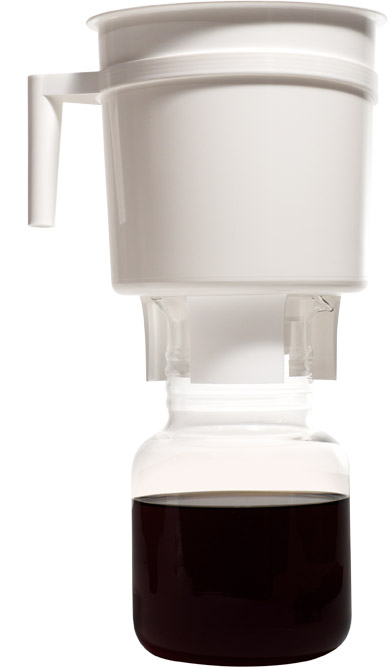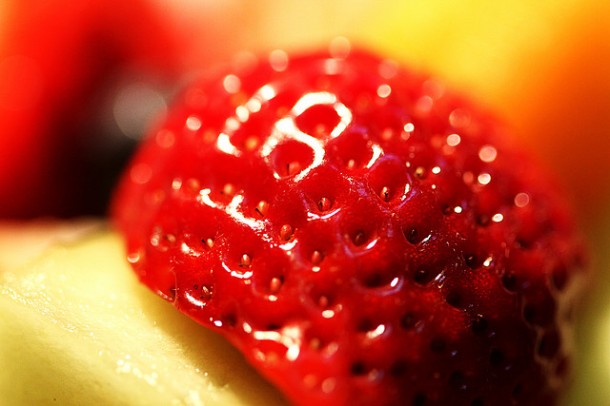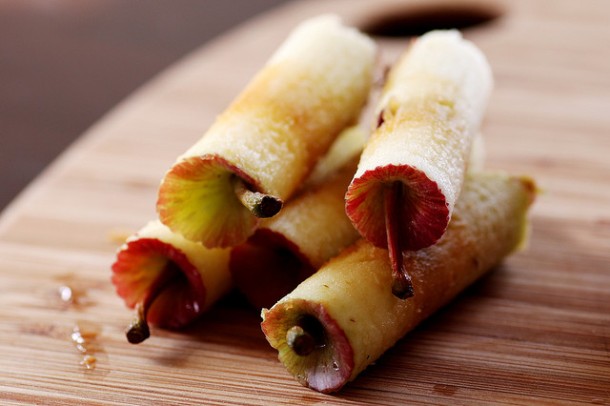Food Science Careers & Bad Apples
Kirsten Schimoler at Ben & Jerry’s talks about food science as a career and scientists figure out how to keep produce healthier.
Read more
Kirsten Schimoler at Ben & Jerry’s talks about food science as a career and scientists figure out how to keep produce healthier.
Read more
Nothing says “summer” quite like a big, juicy slice of watermelon. Even if you prefer it charred on the grill or blended into an icy agua fresca, watermelon is one of the best ways to beat the late-summer heat.
So what gives watermelon its refreshingly delicate flavor?
Turns out the answer is pretty complicated. Over the last few decades, scientists have identified dozens of flavor and aroma molecules that contribute to watermelon’s unique taste [1].
And here’s an interesting twist: a watermelon’s flavor has a lot to do with its color. Chow down on a yellow ‘Early Moonbeam,’ a pale ‘Cream of Saskatchewan,’ or a deep red ‘Crimson Sweet’ and you’ll likely notice different flavor profiles for each melon.

These watermelons don’t just look different, they taste different, too! (David MacTavish/Hutchinson Farm)
Several of watermelon’s flavor molecules form when colorful chemicals called carotenoids break down into smaller chemical compounds [2,3].
For example, the classic color of red watermelons comes from lycopene, the same molecule responsible for the color of red tomatoes. When lycopene breaks down, it forms key flavor compounds such as lemon-scented citral.
Orange melons don’t have much lycopene, but they make up for it with extra beta-carotene. This chemical – the same one that makes carrots orange – leads to a completely different set of flavor molecules, including floral beta-ionone.
 |
| Colorful molecules called carotenoids break down into different flavor compounds. Figure adapted from [2]. |
The chemistry of watermelon flavor is clearly complex, but scientists are still searching for individual molecules that mimic watermelon’s characteristic taste.
Most recently, a study identified a single molecule – dubbed “watermelon aldehyde” – that has a very distinct watermelon aroma [4]. Unfortunately (or fortunately, depending on your perspective), the molecule is too unstable to be used as a food additive. So for now, artificially flavored “watermelon” products will just have to keep on tasting nothing like watermelon.
Good thing there’s plenty of real, chemically complex watermelon to go around.
References
 About the author: Liz Roth-Johnson received her Ph.D. in Molecular Biology at UCLA. If she’s not in the lab, you can usually find her experimenting in the kitchen.
About the author: Liz Roth-Johnson received her Ph.D. in Molecular Biology at UCLA. If she’s not in the lab, you can usually find her experimenting in the kitchen.
Hot or cold, temperature won’t stop many from obtaining their caffeine fix. Depending on the weather and personal preferences, coffee drinkers at home can brew coffee by one of two ways: hot brew or cold brew.
Many are familiar with hot brew coffee. The equipments used for hot brew are widely recognized, and even iconic: the moka pot, French press, Vietnamese coffee filter, and Chemex, to name a few. These equipments, as with all hot brew techniques, involve pouring hot water over a bed of coffee grounds, at a general proportion of 1 oz. coffee to 8 oz. hot water [1]. (That’s 2 level tablespoons per 1 cup of water, on a more home-friendly scale.) The resulting liquid, coffee, is then separated from the grounds and ideally consumed as soon as possible.

Left: Moka pot. Photo Credit: Bill Rice (billrice/Flickr) | Middle: French press/press pot. Photo Credit: Bodum | Right: Vietnamese coffee filter. Photo Credit: Marko Mikkonen (markomikkonen/Flickr)
Cold brew demands more patience. In a Mason jar, French press, or Toddy system, coffee grounds are mixed with room temperature water, and then left to sit for hours—anywhere from three to twenty-four hours—before the solids are filtered out. Cold brew recipes often call for a higher coffee to water ratio: 1 part coffee to 4 parts tepid water, which compared to hot brew, is 2 oz. coffee per 8 oz. water (roughly 4 tablespoons per 1 cup water). Once the grounds are removed, what’s left is black coffee concentrate that is thinned with water or milk before it is served.

Toddy System for cold brew. Photo credit: Toddy
On the surface, the distinctions between the two methods seem self-explanatory. Hot brew quickly produces fragrant java with bite and acidity, whereas cold brew rewards patience with condensed coffee that is smooth and sweet. To begin to understand the flavor profile differences, it helps to first get acquainted with the coffee grounds.
Coffee grounds contain a hodgepodge of volatile and non-volatile components, such as various oils, acids, and other aromatic molecules [2]. Collectively, these compounds that are found in coffee grounds are referred to as “coffee solubles” and significantly contribute to coffee flavor [2]. Brewing is the process of extracting these components from the grounds, so coffee beverages are technically a solution of coffee solubles and water. Given that coffee grounds are used in both of our brewing methods, the principle variables are temperature and time.
Temperature affects the solubility and volatility of the coffee solubles. Relative to brewing, solubility describes the ability of the solubles to dissolve out of the grounds and into the water; volatility refers to their ability to evaporate into the air. Coffee solubles dissolve best at an optimal temperature of 195-205°F [3]. With more coffee solubles extracted, hot brew coffees are described as more full-bodied and flavorful when compared to cold brew. Moreover, due to increased volatility with higher temperatures, the aromatics are more readily released from coffee, giving rise to that beloved scent of freshly-brewed coffee.
On the downside, oxidation and degradation also occur more rapidly at higher temperatures. The oils in coffee solubles can oxidize more quickly at elevated temperatures, causing coffee to taste sour. Acids also degrade, the most notable of which is chlorogenic acid into quinic and caffeic acid, causing coffee to taste bitter [2].
Where cold brew lacks in temperature, it makes up for in time. Coffee solubles have markedly decreased solubility in room temperature water. Increasing the brew time from a few minutes to many hours aims to maximize extraction of the solubles from the grounds. Even over twenty-four hours, not all the coffee solubles will have dissolved; this is why the amount of coffee grounds is doubled, in an effort to make up for the lower extraction rate. In comparison with hot brew, cold brew is sometimes described as tasting “dead” or “flat” due to the lower yield of coffee solubles [3]. Further, decreased volatility prevents aromatics from escaping from coffee as easily, so cold brew is much less perfumed than its hot brew counterpart.
Oxidation and degradation will still occur in cold brew methods, but this happens much more slowly; bitterness and acidity are just about absent in cold brew coffee, especially if it is kept cold. Though, cold brew doesn’t merely taste like hot brew without the bitterness. Fans of the cold brew method have emphasized that cold brews contain a completely different flavor profile that can’t be found with hot brews. Going back to the idea of solubility, not all flavor compounds of coffee solubles are equally soluble. A good majority of the coffee solubles are still able to leach out of the grounds, even in colder water. The compounds that don’t dissolve are the ones often attributed to unfavorable flavors [4]: these stay in the grounds that are subsequently tossed away. Consequently, cold brews take on a much sweeter, floral profile.
To note, brew time does not determine caffeine content, nor does bitterness indicate coffee strength. Caffeine is extracted early in the brewing process, so extending brew time, by either method, would only result in over-extracted coffee [1]. Coffee “strength” is defined as the amount of dissolved coffee solubles per unit of coffee volume [1]. On that train of thought, cold brew certainly produces stronger coffee, given that the brewing process purposely concentrates the coffee solubles. Though, keep in mind that rarely anyone drinks cold brew coffee straight up; many enjoy this smooth drink diluted with milk or water.
Whether you’re an adamant hot brew addict or a die-hard cold brew fanatic, at least coffee drinkers can agree that as long as there’s caffeine, everything’s mellow.
References cited
 About the author: Alice Phung once had her sights set on an English degree, but eventually switched over to chemistry and hasn’t looked back since. Read more by Alice Phung
About the author: Alice Phung once had her sights set on an English degree, but eventually switched over to chemistry and hasn’t looked back since. Read more by Alice Phung
Supermarket strawberries have become bland through decades of agriculture, so now scientists are figuring out how to bring its flavor back. In the meantime, that banana isn’t going to help with your caffeine jitters.
Read more
Fruit salad can be made throughout the year, but nothing beats a crisp fruit medley on a hot summer afternoon. There are very few limits on what can be a fruit salad ingredient. If the object in question is fruit, it can go in. Segregating fruit from non-fruit seems simple, but from a botanical point of view, classifying these sweet and juicy plant products gets complicated. But, if armed with knowledge and lemon juice, anyone can achieve this delicious and vibrant potluck offering.
A fruit is the structure of a plant that bears the seeds. A plant’s flower houses the female reproductive parts, namely the ovary, in the flower’s center. When fertilized, parts of the ovary develop into seeds, and the rest becomes the fruit.
Berries or Not?
The average person defines a berry as anything whose name ends in the suffix, –berry. But to a botanist, a berry is a fruit containing multiple seeds in its interior, embedded in the flesh of the ovary. This includes blueberries, tomatoes, eggplants, grapes, bananas, persimmons, and chili peppers [1]. A botanically-correct berry salad could be very savory; perhaps very spicy.
Blackberries, mulberries and raspberries all fall into the category of berry-imposters called aggregate fruits. Each little bump on a raspberry or blackberry is actually an individual fruit, as each is its own separate ovary, formed from one flower.
Botanically speaking, strawberries are actually not berries. Each pock on the fruit’s exterior is called an achene, and each achene is an individual fruit with a corresponding seed in the interior. The thing we call a strawberry is not a berry in the botanical sense, but rather an accessory tissue for an aggregate fruit (the achenes), formed from multiple ovaries of one flower. [2]

The “seeds” are actually achenes, and they are the true fruit of the strawberry plant. Photo Credit: Dome Poon (Flickr/MoHotta18)
Neither Pine nor Apple, and Not a Nut
A pineapple is considered a multiple fruit. Whereas an aggregate fruit forms from one flower, a multiple fruit is the product of the fused ovaries of a cluster of flowers, thus each pineapple is one large composite fruit. Want to impress guests with a “multiple fruit” fruit salad? Your (somewhat limited) options include breadfruit, osage-orange, fig, and pineapple [3].
Coconut is Not a Nut
Technically speaking, a coconut is a fibrous one-seeded drupe. A drupe is a fruit with a seed enclosed by a hard stony shell, like a peach or olive. An unprocessed coconut has three layers. The smooth, green, outermost layer is called the exocarp. The next layer is the fibrous husk, or mesocarp, which surrounds the hard woody endocarp, which surrounds the seed. A supermarket coconut usually has been freed of its two outer layers. The part most likely found in a fruit salad are just shavings of the seed’s endosperm. This delicious white lining is meant to nourish the seedling coconut tree as it germinates [3].
Keeping Fruit Salad Colorful
Apples, pears, and bananas notoriously turn an unattractive brown after dicing. This is because they contain an enzyme called polyphenol oxidase [4]. When the fruit is sliced, the enzyme is free to react with oxygen, as well as iron-containing phenols in the apple cells that had previously been kept separate. The products of these reactions are ugly, brown chemicals.

The middle of these apple cores have begun to brown. Photo credit: Stacy Spensly (Flickr/notahipster)
The key to preventing or slowing any enzymatic reaction is denaturing the enzyme. Heat will do the trick, as will reducing the fruit’s contact with oxygen by putting cut fruit under water or vacuum packing it. The simplest way to avoid browning is to apply lemon juice or another acidic substance on the cut surface. Enzymes can only function within a specific pH range, and acidic lemon juice will reduce the pH on the surface of the fruit. For those who fiercely oppose brown apples, try adding add sulfur dioxide [4], a chemical that acts as a preservative by binding to reactants in the fruit to interrupt the browning reaction. For anyone truly passionate about keeping their sliced fruits bright, upgrading to a sharper knife can help. A low quality steel knife may be corroded, and can make more iron salts available for the browning reaction.
References cited
 About the author: Elsbeth Sites is pursuing her B.S. in Biology at UCLA. Her addiction to the Food Network has developed into a love of learning about the science behind food.
About the author: Elsbeth Sites is pursuing her B.S. in Biology at UCLA. Her addiction to the Food Network has developed into a love of learning about the science behind food.
Imagine yourself in elementary school parading through the auditorium during your school’s coveted science fair. You round the corner, nearly knocking over the perfectly aligned row of tri-fold poster boards, when you happen upon the fair’s pièce de résistance. Suddenly, science has never been so cool. It’s an erupting volcano! You’re ooh-ing and ahh-ing as you watch the “molten hot lava” spew out from the angry papier-mâché mountain. You inquire about the sour smell in the air and are told by your classmate that this tabletop magic was nothing more than a perfectly planned mixture of vinegar and baking soda.
Vinegar is an aqueous solution that contains acetic acid and water. Historically, vinegars were often produced by exposing wine to contamination by harmless, airborne bacteria known as Acetobacter. Drosophila melanogaster, a geneticist’s model friend, commonly known as the fruit fly, is regarded as a potent vector for the propagation of the bacterium. This particular strain of bacteria facilitates the conversion of ethanol, through aerobic oxidation, into the major component of vinegar: acetic acid. Water is often added to commercially available vinegars to make the substance more suitable for household handling and consumption [1].
The volcano experiment is a simple case of an acid-base reaction where the baking soda, a sodium bicarbonate (NaHCO3), reacts with acetic acid (C2H4O2) in the vinegar to produce an intermediate product known as carbonic acid (H2CO3). The intermediate decomposes and is converted into a carbon dioxide (CO2) gas, which rapidly escapes from the solution accounting for the reaction’s eruptive characteristic [2].
But enough about chemistry, what about the food?
Vinegar has a plethora of culinary applications and serves as an effective food preservative and delicious sour condiment. From soup dumplings to pickles, vinegar is here to stay! Quite literally, the acidic characteristic (pH less than 4) of vinegar prevents harmful bacterial growth that allows for an extended, indefinite shelf life. So store your vinegar properly and you will be able to keep it for a very long time!
The variety of vinegars is limitless and can be made from virtually anything that contains sugar. Alcoholic fermentation involves the conversion of carbohydrates into ethanol, which can later be converted into acetic acid. One of the most widely available vinegars in the Philippines is coconut vinegar and is made from fermented coconut water. It is typically used to tenderize meat, which is accomplished when peptide bonds in complex protein structuresare disrupted. But it often served as a side condiment to season many different dishes.
Two of my favorite Filipino dishes are called (I) KINILAW (key-knee-lauw) and (2) SISIG (see-seg) and are both prepared with ample amounts of vinegar. The kinilaw is a style of ceviche that infuses ginger and relies on the acidic nature of vinegar to “cook” the fish used in the dish. Lastly, sisig is popular dish in the city of Pampanga and translates to “to snack on something sour”. It is often served with sizzling vinegar marinated pork belly, spicy chili peppers, fresh red onions, cracked egg and native limes to add additional sourness.
I recently prepared dinner for 30 friends for my project called PATAO and shared these two delightfully vinegar-y dishes with them! Thankfully no one was a sourpuss and received the dishes with much joy. Check out their reactions here:
[vimeo http://vimeo.com/102508485]
Video Credit: Jimmy Sianipar
References cited
 About the author: Anthony Martin received his Ph.D. in Genetic, Cellular and Molecular Biology at USC and is self-publishing a cookbook of his favorite Filipino dishes.
About the author: Anthony Martin received his Ph.D. in Genetic, Cellular and Molecular Biology at USC and is self-publishing a cookbook of his favorite Filipino dishes.
